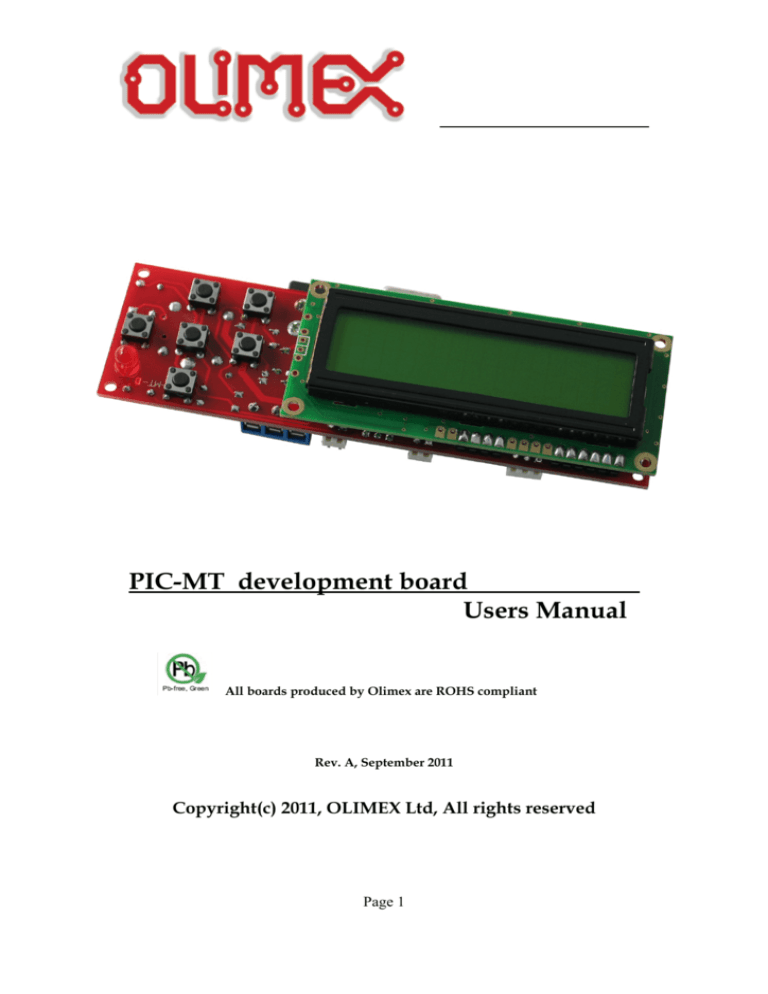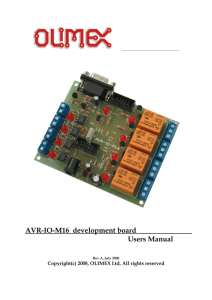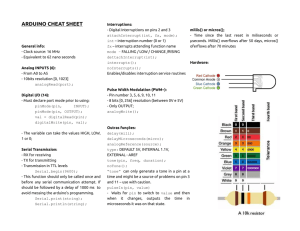
PIC-MT development board
Users Manual
All boards produced by Olimex are ROHS compliant
Rev. A, September 2011
Copyright(c) 2011, OLIMEX Ltd, All rights reserved
Page 1
INTRODUCTION:
PIC-MT is development board for 28 pin PIC microcontroller. With its
LCD, six buttons, RELAY, USB, RS232, ICSP, DALLAS, FREQUENCY and ADC
connectors this board is suitable for different embedded systems applications.
BOARD FEATURES:
–ICSP/ICD connector for programming with PIC-MCP-USB, PIC-MCP or
PIC-PG1, PIC-PG2, PIC-PG3, PIC-PG4 and debugging with PIC-ICD2, PICICD2-POCKET, PIC-ICD2-TINY(* for the PICs with ICD support) for
PIC16F87X there is low cost PIC-ICD1
–Dallas touch button port
–Frequency input
–0-10V and 0-5V ADC input with buffer OAMP
–RS232 DB9 female connector
–RS232 interface circuit with Tx, Rx signals
–RS232 TTL levels output connector
–Voltage regulator +5V, 78L05 and filtering capacitors
–Quartz crystal oscillator circuit 20Mhz
–DIL28 microcontroller socket
–Relay with 10A/250VAC contacts
–Buzzer
–Status LED on RB4
–Four mounting holes
–Power plug-in jack
–FR-4, 1.5 mm (0,062"), green soldermask, white silkscreen
–Dimensions 120x36 mm (4,7x1,4")
Page 2
component print
ELECTROSTATIC WARNING:
The PIC-MT board is shipped in protective anti-static packaging. The board must
not be subject to high electrostatic potentials. General practice for working with
static sensitive devices should be applied when working with this board.
BOARD USE REQUIREMENTS:
Cables:
Depends on the used programming/debugging tool. It could be 1.8
meter USB A-B cable to connect PIC-Kit3, PIC-ICD2-POCKET, PIC-ICD2, PICMCP-USB to USB host on PC, RS232 cable in case of PIC-PG1, PIC-PG2, PIC-PG4,
PIC-ICD2-TINY, PIC-MCP, LPT cable in case of PIC-PG3, or other
programming/debugging tools.
Hardware:
Programmer/Debugger – some of Olimex programmers are
applicable, for example PIC-PG1, PIC-PG2, PIC-PG3, PIC-PG4, PIC-Kit3, PICICD2, PIC-ICD2-POCKET, PIC-ICD2-TINY, PIC-MCP, PIC-MCP-USB or other
compatible programming/debugging tool.
Page 3
Page 4
+
REL1
6
7
8
9
1
2
3
4
5
DB9-FEMALE
T3
2N3904
REL1
C6
22p
1K
R11
RELAY
100n
C2
LCD1
LCD2
C5
22p
1N4004
D12
LM358
7
U2B
+12V
4
RELAY-3
6
5
OUT
GND
+5V
6
5
4
3
2
1
1
2
3
4
Q1
20MHz
E
RELAY
RS
R/W
E
R/W
RS
9
10
11
12
13
14
2
3
4
5
6
7
1
+5V
R12
10K
VDD
1N4148
D8
4
3
2
1
C7
10uF/25VDC
10K
R5
18
17
16
15
28
27
26
25
24
23
22
21
TXD
+5V
RXD
TXD
RXD
TXD
+5V
RS232
PIC_28pin
RX/RC7
TX/RC6
RC5
RC4
PGD/RB7
PGC/RB6
RB5
RB4
PGM/RB3
RB2
RB1
INT/RB0
100n
C4
R4
4.7K
GND
T2
2N3906
R17
330
R16
10K
+5V
OSC1/CLKIN
OSC2/CLKOUT
RC0/T1OSO
RC1/T1OSI
RC2/CCP1
RC3
VSS
RA0/AN0
RA1/AN1
RA2/AN2
RA3/AN3
RA4/T0CKI
RA5/AN4
MCLR#/THV
U1
100uF/16VDC
C3
8
19
RELAY-2
RELAY-1
+12V
R15
10K/1%
R14
10K/1%
IN
VR
78L05
+
D14
1N4148
D13
1N4148
1
2
3
220uF/25VDC
C1
+12V
8
1
2
+5V
ADC
1N4004
D1
20
FREQ
-2
-1
PWR +
R7
D9
1N4148
10K
R1
4.7K
B4
B1
ICSP
BUZZER
1
2
3
4
5
6
T1
2N3904
RXD
R3
4.7K
B6
1N4148
D7
1N4148
D4
DALLAS
1
2
+
http://www.olimex.com/dev
COPYRIGHT(C) 2005, OLIMEX Ltd.
Rev. D
PIC-MT
1N4148
1N4148
R6
10K
D6
D5
R2
4.7K
1N4148
B5
B3
D11
FR107
1N4148
+5V
D3
B2
LED
D10
FR107
D2
330
R10
33
R8
R9
4.7K
+5V
SCHEMATIC:
BOARD LAYOUT:
POWER CIRCUIT:
PIC-MT takes power via PWR jack. The power supply should be in range +10 to
+14VDC.
RESET CIRCUIT:
PIC-MT reset circuit includes R12 (10k) pull-up, ICSP pin 1, U1 - pin 1
(MCLR#/THV).
CLOCK CIRCUIT:
Quartz crystal Q1 (20 MHz) is connected to U1 pin 9 (OSC1/CLKIN) and pin 10
(OSC2/CLKOUT).
Page 5
JUMPER DESCRIPTION:
- There are no jumpers on this board.
INPUT/OUTPUT:
Buttons connection:
The Button interface uses three microcontroller ports RB0, RB1, RB2. The ports are
connected with pull down resistors and are read as “0”. To scan the buttons user
should set one of the ports in “1” and to check the other two ports.
For example: set port RB0 as output RB1, RB2 as inputs and make RB0= 1. If buttons
B1 is pressed RB1 will be “1” too, if button B6 is pressed RB2 will be “1” too. The
same way you can scan all other buttons
LCD 16x2 display without BACKLIGHT.
LCD connection:
LCD is connected for 4-bit interface
RS - LCD register select RA2
R/W – LCD read write select RA3
E - LCD enable RA5
D4 – RC0
D5 – RC1
D6 – RC2
D7 – RC3
Sample demo program how to drive the LCD is available on Olimex’s site.
Buzzer with name BUZZER, connected to U1 pin 15 (RC4) and pin 16 (RC5).
User must apply frequency to these microcontroller pin to sound:
RC4=0, RC5=1, delay, RC4=1, RC5=0, delay
Status Led (red) with name LED connected to U1 - pin 25 (RB4). LED is ON when
RB4=0.
RELAY with name REL1, connected to U1 pin 3 (RA1).
EXTERNAL CONNECTORS DESCRIPTION:
ICSP:
Pin #
Signal Name
1
MCLR#/THV
2
+5V
3
GND
4
U1 – pin 28 (RB7)
5
U1 – pin 27 (RB6)
6
U1 – pin 24 (RB3)
Page 6
ICD/ICSP connector layout:
The ICD/ICSP connector is 6 pin with 0,1" step.
The PIN.1 is marked with square pad on bottom and arrow on top. ICSP signals are: 1- MCLR, 2VDD, 3- VSS/GND, 4- PGD/RB7, 5- PGC/RB6, 6- PGM/RB3.
Programming:
To program PIC-MT you need serial port or parallel port PIC programmers with ICSP connector.
The serial port ICSP programmer (PIC-PG1) works with IC PROG ICPROG software, written by
Bonny Gijzen. The latest release of ICPROG may be download for free from http://www.icprog.com
RS232:
Pin #
Signal Name
1
TXD
2
RXD
3
GND
4
+5V
RS232 interface connection:
TTL connector: PIN.1 (square) –TXD, PIN.2 –RXD, PIN.3 – GND, PIN.4 – VCC.
ADC:
Pin #
Signal Name
1
Input for ADC, which is directly
connected to buffer LM358 and after
the buffer is connected to U1 pin 2
(RA0/AN0)
2
Input for ADC, which is connected via
divider 10 kΩ/10 kΩ to buffer LM358
and after the buffer is connected to U1
pin 2 (RA0/AN0)
3
GND
Input voltage may be 0-5V between PIN.2 and PIN.3 (GND) or 0-10V between PIN.1 and PIN.3.
DALLAS:
Pin #
Signal Name
1
U1 pin 26 (RB5)
2
GND
Page 7
Dallas iButton interface:
Connected to PB5 via protection circuit.
Dallas connector: PIN.1 (square) – Dallas input, PIN.2 – GND.
FREQ:
Pin #
Signal Name
1
U1 pin 6 (RA4)
2
GND
RS232 DB9 female connector:
Pin #
Signal Name
1
Not Connected
2
TXD – U1 pin 17
3
RXD – U1 pin 18
4
Not Connected
5
GND
6
Not Connected
7
Not Connected
8
Not Connected
9
Not Connected
Pin #
Signal Name
1
RELAY1(Normal
Open)
2
RELAY2(COMMON)
3
RELAY3(Normal
Close)
Pin #
Signal Name
1
Power Input
2
GND
REL:
PWR:
Page 8
AVAILABLE DEMO SOFTWARE:
•
Blink LED for PIC16F876 demo code (C source and HEX)
•
Buzzer, relay, buttons LCD for PIC16F876 demo code (C source and
HEX)
•
LCD write demo code for PIC16F876 demo code (C source and HEX)
•
RS232 send receive for PIC16F876 demo code (C source and HEX)
Page 9
ORDER CODE:
PIC-MT - completely assembled and tested.
How to order?
You can order to us directly or by any of our distributors.
Check our web www.olimex.com/dev for more info.
Revision history:
Manual's revision:
Rev. A
Board's revision:
Rev. D – created March 2005
Page 10
- created September 2011
Disclaimer:
© 2011 Olimex Ltd. All rights reserved. Olimex®, logo and combinations thereof, are registered trademarks of
Olimex Ltd. Other terms and product names may be trademarks of others.
The information in this document is provided in connection with Olimex products. No license, express or implied
or otherwise, to any intellectual property right is granted by this document or in connection with the sale of
Olimex products.
Neither the whole nor any part of the information contained in or the product described in this document may be
adapted or reproduced in any material from except with the prior written permission of the copyright holder.
The product described in this document is subject to continuous development and improvements. All particulars
of the product and its use contained in this document are given by OLIMEX in good faith. However all warranties
implied or expressed including but not limited to implied warranties of merchantability or fitness for purpose are
excluded.
This document is intended only to assist the reader in the use of the product. OLIMEX Ltd. shall not be liable for
any loss or damage arising from the use of any information in this document or any error or omission in such
information or any incorrect use of the product.
Page 11







